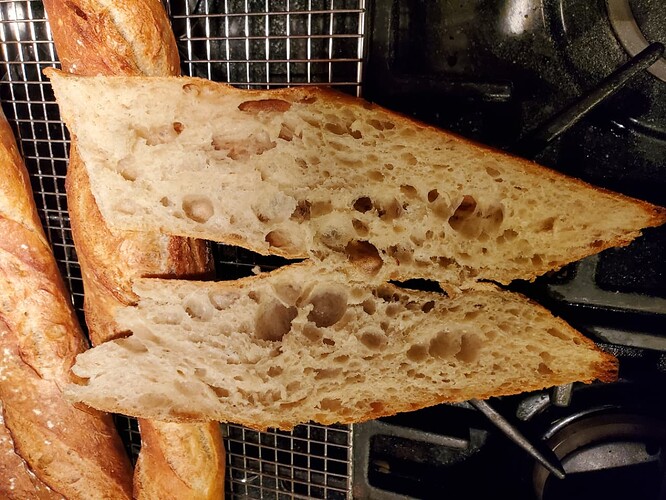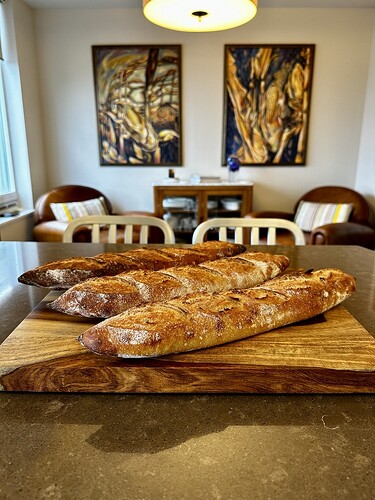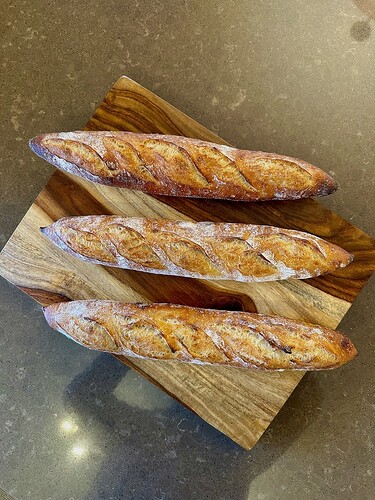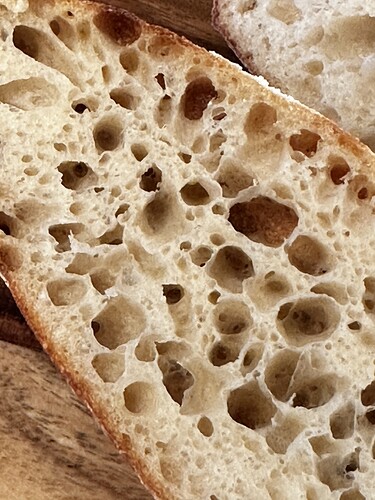Melissa Johnson has been SO patient and helpful! Can’t tell you how much I appreciate it.
These pix are of the batch I just made using “autolyse” instead of “poolish”. Very smooth and elastic dough but the interior is still not as “open” as I’d like. This interior was also a bit pasty. Melissa suggested I reduce the amount of diastatic malt powder which I will do next time. Wondering whether I should let the dough double BEFORE putting it in the refrigerator for the slow fermentation.
I’m happy to help and love baguettes. Hopefully here in the forum, we also get some crowdsourcing of ideas. I think your crumb is actually quite open on the side where I’m guessing the score bloomed nicely. I wonder if you could get more even openness working on your scoring.
This diagram from @Benito 's Yorkville poppyseed baguette recipe shows the ideal placement of the cuts.
Regarding doubling before refrigeration – I think that depends on the power of your yeast and the temp of your refrigerator. For sourdough especially in the winter when my dough temp is often in the 60s, I don’t refrigerate unless the dough is mostly done with my target expansion or I plan to have it rise again at room temp. But warm sourdough and also yeast doughs tend to keep expanding in the my refrigerator.
Thank you! I’ll try your scoring advice with the next batch which I’ll do soon. I’ll experiment with the doubling / refridge, etc.
This is a great site and much appreciated!
mac
I have found that to get open crumb in baguettes while still getting ears/grigne is a fine balance. If you ferment the dough too much, you’ll get great crumb at the expense of the grigne/ears. If you ferment too little you’ll get great ears/grigne but more closed crumb. I can’t say that I have ever allowed the dough to double for either sourdough or commercial yeast baguettes.
My most recent bake of my Yorkville SD baguettes.
For these I ended bulk fermentation at a rise of only 20% (as measured in an aliquot jar) going straight into division and pre-shaping. After a short rest, the dough is shaped and placed into a couche until the aliquot jar showed a rise of 55%. I then placed the dough in the couche into the fridge for 15-30 mins to firm it up a bit to make the scoring easier followed by baking.
I would guess that fermentation isn’t likely the issue with your crumb. You crumb looks quite good overall. You shaping might just need a bit more work to get a more even shape and then more even open crumb. If we degas the dough too much with shaping or even when flipping the dough out of the couche, it can cause crumb to tighten in places.
Benny
Hi, Benny:
And thanks SO much for the quick and comprehensive reply!
Those baguettes are precisely what I’m trying to get to! Gorgeous!
Am I to understand, then, that there is no stretch & fold, no bench folding, etc.? Just the 20% rise then division and pre-shape? Then formed and “couched” until about 55% rise. Great idea to refrigerate for a bit to make the scoring easier. I always fear the lame or knife dragging. And, perhaps, I’m not gentle enough when shaping which would, I suspect, be helped by the firmer, chilled dough?
Best Regards,
mac
Hi, Benny:
Sorry to bother you. Don’t know whether my original reply got through.
Question: When you say you allow for 20% rise after bulk fermentation, that’s after the stretch / fold (or bench fold) of the hydrated dough? In other words (and please forgive me if I’m being dense), hydrate, s & f, then 20% rise, or…hydrate, s & f, refrigerate for a day or two and then 20% rise before shaping?
Thank so much,
mac
Hi Mac
After the dough is developed with slap and folds or in the mixer, I remove some dough for the aliquot jar. This is before the stretch and folds. To be more clear, here is what I do.
Levain starter 16 g
Water 24 g
AP flour 47 g
Final dough
AP flour 475 g
Water 347 g
Bassinage water 21 g
Salt 10 g
Diastatic malt 5.2 g
Overnight Levain build ferment 75°F 10-12 hours
78°F 9 hours to peak
In the morning, to your mixing bowl add water and diastatic malt to dissolve, then add levain. Use your spatula to cut the levain into small pieces. Next add AP flour and mix to combine. Allow to fermentolyse for 10 mins. Slap and fold x 100 then add salt and hold back water gradually working in until fully absorbed by massaging and then Rubaud kneading the dough, then slap and fold x 200. Can also use your stand mixer.
Bulk Fermentation 82*F until aliquot jar shows 20% rise.
Do folds every 20 mins doing 3 folds
Could do cold retard at this point for up to overnight. (Aliquot jar 20% rise)
Divide and pre-shape rest for 15 mins
Shape en couche with final proof until aliquot jar shows 55% rise then (optional) cold retard shaped baguettes en couche for at least 15 minutes for easier scoring. I often do this for convenience as the oven is pre-heating.
Pre-heat oven 500*F after 30 mins add Silvia towel in pan with boiling water.
Transfer baguettes from couche to peel on parchment
Score each baguette and transfer to oven, bake on steel.
Bake with steam pouring 1 cup of boiling water to cast iron skillet dropping temperature to 480*F.
The baguettes are baked with steam for 13 mins. The steam equipment is removed venting the oven of steam. Transfer the baguettes from the baking steel to next rack completing baking directly on a rack to minimize the browning and thickening of the bottom crust. The oven is dropped to 450ºF but convection is turned on and the baguettes bake for 10 mins rotating them halfway. The baguettes are rotated again if needed and baked for another 3 mins to achieve a rich colour crust.
I hope that helps clarify things.
Benny
Hello again, Benny:
Thanks a million for your incredibly thorough and detailed reply! I so appreciate it!
I don’t make or use a sourdough starter, just a good commercial instant yeast but I will do my best to make use of all the direction and advice you offered. I, too, started by using a “steel” which is great for pizza but was burning the bottoms of the baguettes SO…I’ll try your suggestion of moving them to a rack.
You folks are so generous with your time and expertise! Clearly, it is a labor of love for you.
Best Regards and Thanks Again,
mac
@mackenzieallen You might be interested in the Poolish timing and percentage chart @Benito just posted here:







